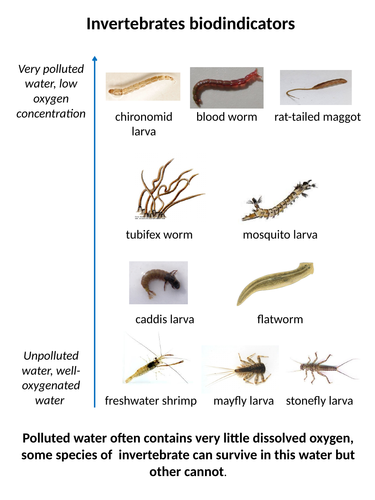

This lesson is designed for the NEW AQA Trilogy Biology GCSE, particularly the ‘Ecology’ SoW.
For more lessons designed to meet specification points for the NEW AQA Trilogy specifications for Biology, Chemistry and Physics please see my shop: https://www.tes.com/teaching-resources/shop/SWiftScience
The first task is for pupils to consider the ways in which scientists can measure water pollution. Pupils will need to match the piece of equipment to the description of how it is used. Pupils can then assess their work using the answers provided.
The next task is for pupils to think about living indicators of pollution, they can think > pair > share their ideas about what living organisms might give us an idea of the pollution levels in the local environment. After a class discussion the information on the PowerPoint slide will outline some of these examples of bio-indicators.
The next task focuses on water bio-indicators, pupils will be in groups and one at a time get a chance to look at a poster of organisms which live in polluted to unpolluted water. Pupils will view the poster and then have to go back to their desks to try and recreate as much of it as they can. After a set period of time (as it could go on forever!) pupils can then assess their work against the poster and see how well they did.
The next part of the lesson focuses on bioaccumulation of chemicals in marine organisms, pupils will have the chance to read through an article and will need to use the information in the article to come up with their own definition of ‘bioaccumulation’. Once pupils have completed this task you can reveal the definition for bioaccumulation and a diagram to simply depict how this process occurs in marine environments.
The last part of the lesson looks at eutrophication, pupils will firstly watch a video about this process and will need to answer questions whilst watching. Once this is complete they can mark their work using the answers provided. Finally pupils will be given a blank cartoon strip, for which they will need to select the correct captions to go with the correct stage in the process of eutrophication as well as draw a diagram to depict this stage.
The plenary task for pupils is for them to pretend they work for an environmental charity, they need to tweet a message to raise awareness abut the effect water pollutants can have on local biodiversity.
All resources are included at the end of the presentation. Thanks for looking, if you have any questions please let me know in the comments section and any feedback would be appreciated :)
Get this resource as part of a bundle and save up to 56%
A bundle is a package of resources grouped together to teach a particular topic, or a series of lessons, in one place.
Something went wrong, please try again later.
Report this resourceto let us know if it violates our terms and conditions.
Our customer service team will review your report and will be in touch.
